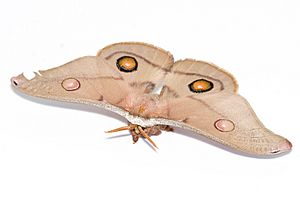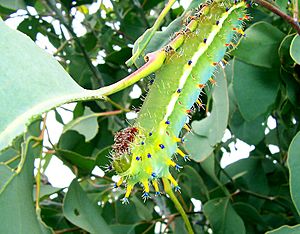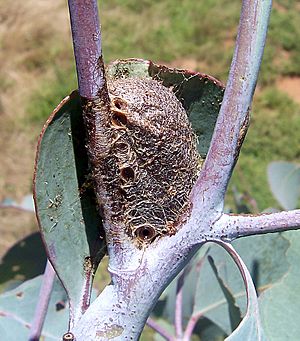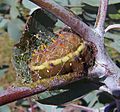Emperor gum moth facts for kids
Quick facts for kids Emperor gum moth |
|
|---|---|
 |
|
| A female emperor gum moth | |
| Scientific classification | |
| Synonyms | |
|
Antheraea eucalypti Scott, 1864 |
The Emperor Gum Moth (Opodiphthera eucalypti) is a large and beautiful moth native to Australia. It belongs to the family Saturniidae. These moths are known for their impressive size and striking appearance, both as caterpillars and as adult moths. They can also be found in New Zealand, where they were introduced.
Contents
What do they look like?
Emperor Gum Moths are very large, with a wingspan of about 12 to 15 centimeters (4.7 to 5.9 inches). The females are usually bigger than the males. Their wings and bodies are covered in soft bristles, making them look furry. The wings are usually a mix of pale reddish-brown colors, with unique patterns. The most noticeable feature is the four large "eye spots" on their wings. The ones on the front wings have reddish-brown rings with pink centers, while the ones on the back wings are black with orange centers. These eye spots help to scare away predators! Male moths have feathery antennae, while females have thinner antennae with fewer hairs.
The caterpillars change their look as they grow. When they first hatch, they are black with tiny hairs. As they get bigger, they go through five stages, shedding their skin each time. In their final stages, they become bright green or blue-green with a yellow or cream stripe down their sides. They also have colorful nodes, or small bumps, of red and blue. Fully grown, these caterpillars can reach up to 12 centimeters (4.7 inches) long!
Where do they live?
Emperor Gum Moths can be found all over Australia, including Tasmania. They are most common in areas with eucalyptus trees, which are their main source of food. They also live in New Zealand, where they were brought over from Australia. You can find them in forests and woodlands.
What do they eat?
Emperor gum moth caterpillars love to munch on the leaves of eucalyptus trees. They have also been seen eating other plants like pepper trees, apricot, birch, and apple trees. Adult Emperor gum moths don't eat at all! They don't even have working mouths. They live only for a short time, using the energy they stored as caterpillars to mate and lay eggs. Life Cycle
Life cycle
- Egg: The female moth lays oval-shaped eggs, about 2 mm long, in rows on eucalyptus leaves. The eggs are light brown or pale yellow.
- Larva (Caterpillar): When the eggs hatch, the caterpillars start eating eucalyptus leaves right away. They grow quickly, shedding their skin five times. The caterpillar stage lasts for many weeks, depending on the weather.
- Pupa (Cocoon): When the caterpillar is ready, it makes a tough, brown cocoon out of silk. It might also use leaves and twigs to help hide the cocoon. The caterpillar turns into a pupa inside the cocoon. This stage can last from a few months to a year, or even longer!
- Adult moth: Finally, in spring or summer, the adult moth comes out of the cocoon. It makes a hole in the cocoon using special hooks on its wings. Adult moths don't live very long, only about a week or two. They spend this time mating and laying eggs.
Fun Facts about Emperor gum moths
- Emperor gum moths are attracted to street lights at night.
- Their cocoons are very strong and can protect the pupa for many years.
- The eye spots on the wings of the adult moth help to scare away predators like birds.
- Emperor gum moths were used in science experiments in the 1960s to help grow cell cultures.
- The hairs on the caterpillars are not poisonous and won't sting you.
- The adult moths rely solely on the energy they stored as caterpillars because they cannot feed.
- The Emperor gum moth can create a cocoon with special germ-fighting abilities, which protects it from harmful bacteria while it changes.
Are they endangered?
While Emperor gum moths are not currently listed as endangered, their numbers seem to be decreasing in some areas. This could be due to things like habitat loss, predators like the European wasp eating the caterpillars, and changes in the environment.
Additional images
See also
 In Spanish: Opodiphthera eucalypti para niños
In Spanish: Opodiphthera eucalypti para niños












